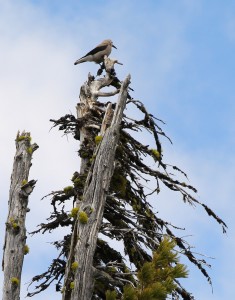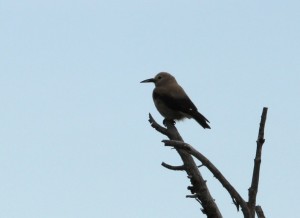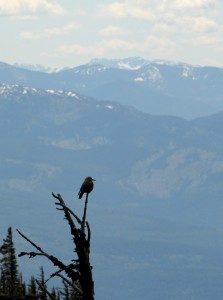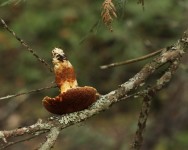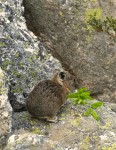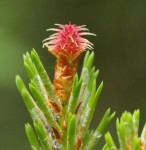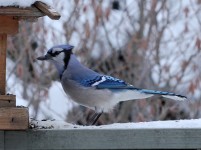Laying eggs in March would be a risky venture for most birds because of the lack of food available to feed nestlings. But an alpine resident–the Clark’s nutcracker– has a system figured out to circumvent that issue.
Like the gray jay, the Clark’s nutcracker caches food when food is available. With a diet consisting mostly of conifer seeds, a Clark’s nutcracker caches between 35,000 to 98,000 seeds between late summer and fall. These cached seeds are the nutcracker’s main food source until the cones are ripe again the next year. Nutcrackers also opportunistically forage for insects, spiders, small birds, small mammals and carrion.
In the northern Rockies, Clark’s nutcrackers mainly forage for the high-protein seeds of whitebark pine, ponderosa pine and Douglas fir. A diet of different seeds is a survival strategy because both ponderosa pine and whitebark pine are masting species (produce a large cone crop every few years).
Since nutcrackers cache seeds, they keep a home range. The home range isn’t usually productive enough to harvest 98,000 seeds, so the nutcracker forages up to 20 miles away for seeds.
Obtaining the seeds isn’t easy, which is why the Clark’s nutcracker has a sharp, sturdy bill. The nutcracker hammers into the ripe cone, which on whitebark pine is closed when mature, to pluck out the seeds.
The Clark’s nutcracker doesn’t carry one seed or even two seeds at a time back to its home range when foraging. Instead, the nutcracker has a pouch beneath its tongue that can hold between 30 to 150 seeds. Once full, the nutcracker flies back to its home range to cache the seeds.
Caches can be in a trench in the ground, in crevices of bark, among tree roots, near fallen logs or branches, or next to rocks. To minimize spoilage and raiding of a large cache by competitors (such as squirrels), the nutcracker places one to 15 seeds in each cache.
Snow covers the caches on or beneath the soil, so nutcrackers cache more seeds in above ground locations for access during the winter. For the caches beneath the soil, the nutcracker uses it bill to swipe away soil to create a trench. Then it places a few seeds in the trench and pushes soil back over the seeds with its bill.
With an amazing memory, Clark’s nutcrackers can remember the location of the caches for nearly nine months–long enough for the first cones to ripen the next summer. If cached in a suitable location, the forgotten seeds will germinate and grow.
The caches of seeds enable the Clark’s nutcracker to court in January or February when most birds are just trying to survive winter. They lay eggs in March (earlier than any other songbird species) with both the male and female incubating the eggs. The male even develops a brood patch on its chest like the female to keep the eggs warm. When a parent isn’t incubating, it goes off to retrieve seeds from one of its caches.
Once the eggs have hatched, the parents utilize the seeds from their caches to feed the young. Researchers speculate that the early nesting allows the young enough time to mature so they can be ready to cache their own seeds once the cones are ripe in late summer.

